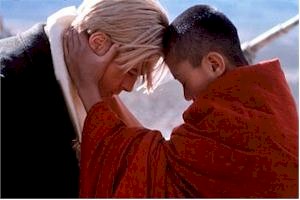A profound story of spiritual transformation
Seven Years in Tibet
Even as I write this belatedly by more months than I care to think about, I am still simply amazed by the poor reception given to this masterful film, which was in my mind, the only contender to Titanic as Best Picture of 1997, and probably even more deserving. After seeing it, I rushed back to see it again as soon as possible, which is something I almost never do. Seven Years in Tibet is a masterpiece, which was destroyed by critics who couldn’t understand it, apparently expecting it to be something it was emphatically not: a story about the Dalai Lama.
Certainly the Dalai Lama figures extremely prominently in the latter portion of the film, but this film is a cinematic translation of Heinrich Harrer’s prosaic memoirs by the same name, and it is infinitely superior to its source book. If you didn’t catch that, let me say it again: This movie is not about the Dalai Lama. This is the true story of the arduous spiritual transformation of Heinrich Harrer, from Third Reich poster boy and all-around asshole, into a genuine and loving human being. One more time: This movie is about an Austrian, not a Tibetan! Understand that, and I think it will be impossible not to love this film.
Harrer, the Aryan poster boy and asshole in question, is played by Brad Pitt. His performance is superb, despite an exaggerated accent at the beginning. Harrer is a young mountain climber, attempting to conquer Nanga Parbat, an unclimbed mountain in the Himalayas, for the greater glory of the Fatherland. So what’s wrong with that? Leaving his very pregnant wife behind, for starters. His pride and self-absorption become almost fatally evident on the expedition when he endangers the lives of himself and the other climbers. The expedition fails due to weather, and the return home fails due to war. The climbers descend into India, a British colony, and are taken as prisoners of war.
In the prison camp, we begin to see the complexity of Harrer’s character, which is just as tormented as it is tormenting. He repeatedly attempts futile escapes by himself, (even though each one brings recriminations down on his comrades left behind), but he finds that he can not escape, neither from the British, nor from himself and his remorse about abandoning his family. A particularly moving scene shows Harrer in the exercise yard during a downpour, repeatedly throwing himself onto the barbed wire as a self-inflicted punishment when he learns his wife has divorced him.
Eventually, Harrer does escape, but only when he learns to cooperate with some of the less impulsive prisoners, one of whom (Peter Aufschnitter, played by David Thewlis) was the captain of the failed expedition. Together, they wander across Tibetan mountains for years, seeking refuge (and generally getting none), fleeing bandits, and clashing as enemies do in the process of becoming the closest of friends. There is great comic relief in some scenes, and magnificent beauty in the starkness and strangeness of their exile. You will now have to see this on video, and you’ll kick yourself for not having seen it on the big screen. Harrer’s transformation begins here, in the cold and isolation of being a man without a country and without a hope, unrelentingly challenged by the beauty of the Roof of the World.
Eventually, both men do find a haven (and friends) in Lhasa, the Tibetan capital. After the war ends, they stay in Tibet, Aufschnitter because he has married and found happiness with a Tibetan woman, and Harrer, because he has nothing to lead him anywhere else. That changes when the 14-year-old Dalai Lama sends for Harrer, and commissions him to build a movie theater adjacent to the Potala Palace. Jamyang Wang Chuck is astonishing in his performance. He is both a humble and capable ruler-in-the-making, winsome beyond belief. He is eager to learn everything possible about the world, and Harrer becomes his tutor. The scenes between Pitt and Wang Chuck are the crowning jewels of the film, filled with sensitivity, humor, and a love that is spiritual as well as friendly and filial. During this, the Chinese begin the war against Tibet, committing atrocities by the millions. Several excellent subplots describe the descent from peace to murderous destruction. Out of duty and love, the young Lama remains with his people. And for the same reasons, he sends his friend away.
Costuming and set design were astonishing. Although Annaud tried every possible avenue to shoot the film in the Himalayas, the Chinese government was successful in intimidating every Himalayan nation to deny him. Nevertheless, the Andean scenery which we do see, is so inspiring it is not easily forgotten, even if we only experience it in the theater. I desperately wanted to get a Seven Years in Tibet calendar, although it appears none were ever made. Pity.
Is there a flaw? The Dalai Lama enters only in the last third of the film, and I don’t think a single viewer would not want to tilt the film so that the bulk of the film was his story, so engaging is his portrayal. Yet to do so, would destroy the nature of this story, which is the transformation of Harrer. And even though the screenplay wisely concentrates much more on Harrer’s relationship with the Lama than the book did, you will leave with a sense of wanting more. Perhaps that is the lesson of Seven Years, that we do not love enough, that when we see how beautiful love truly is, we will regret that we didn’t love more.
Movie still © 1997, Touchstone Pictures



